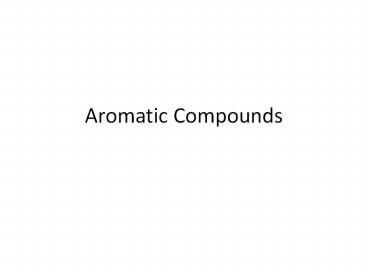Aromatic Compounds - PowerPoint PPT Presentation
Title:
Aromatic Compounds
Description:
Reactions of Side Chains and Attached Functionality on Aromatic Compounds. Treatment of amines with nitrous acid (HONO) generates diazonium salts. The Sandmeyer Reaction. – PowerPoint PPT presentation
Number of Views:166
Avg rating:3.0/5.0
Title: Aromatic Compounds
1
Aromatic Compounds
2
Aromatic Systems are Characterized by Their
Chemical Stability
- Note the chemical stability of the aromatic
systems to the reaction conditions in the
following slides
3
Note aromatic systems stability toward
hydrogenation
4
Note aromatic systems stability toward strong
reducing agent LiAlH4
5
Note the (two) aromatic systems stability toward
Br2
6
Note the aryl iodides stability toward SN2
substitution (SN2 substitution occurs at the sp3
hybridized carbon)
7
Note the aryl iodides stability toward the
strong base (potassium tert-butoxide) used to
effect elimination
8
Reactions of Aromatic Systems Electrophilic
Aromatic Substitution
9
(No Transcript)
10
(No Transcript)
11
(No Transcript)
12
(No Transcript)
13
(No Transcript)
14
The Friedel-Crafts Reaction
15
(No Transcript)
16
Treatment of Aryl Halides with Extremely strong
bases (amide anions, NaNH2, pKa of ammonia 38)
can cause substitution reactions
(note that the above table shows the conjugate
acids only)
17
But the mechanism involves a two-step process of
elimination-addition.
18
(No Transcript)
19
Treatment of aryl halides having strongly
electron-withdrawing substituents (at the 2- and
the 4-position) can also cause substitution
reactions But
20
The mechanism involves addition-elimination.
21
(No Transcript)
22
(No Transcript)
23
(No Transcript)
24
Reactions of Side Chains and Attached
Functionality on Aromatic Compounds
25
(No Transcript)
26
Treatment of amines with nitrous acid (HONO)
generates diazonium salts
27
(No Transcript)
28
The Sandmeyer Reaction
Swiss chemist (1854-1922) after whom reaction is
named
29
(No Transcript)
30
(No Transcript)
31
Benzylic Positions Can be Selectively Oxidized
(all the way to the carboxylic acid) by Potassium
Permanganate
32
(No Transcript)
33
(No Transcript)
34
(No Transcript)
35
The Clemmensen Reduction
36
(No Transcript)
37
(No Transcript)































